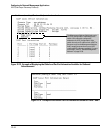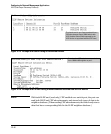
12-50
Configuring for Network Management Applications
LLDP (Link-Layer Discovery Protocol)
LLDP Operating Notes
Neighbor Maximum. The neighbors table in the switch supports as many
neighbors as there are ports on the switch. The switch can support multiple
neighbors connected through a hub on a given port, but if the switch neighbor
maximum is reached, advertisements from additional neighbors on the same
or other ports will not be stored in the neighbors table unless some existing
neighbors time-out or are removed.
LLDP Packet Forwarding: If CDP is globally disabled on a switch, the
switch forwards CDP packets received from a neighbor CDP device instead
of reading and dropping them. However, an 802.1D-compliant switch does
not forward LLDP packets, regardless of whether LLDP is globally enabled or
disabled on the switch.
One IP Address Advertisement Per-Port: LLDP advertises only one IP
address per-port, even if multiple IP addresses are configured by lldp config
< port-list > ipAddrEnable on a given port.
802.1Q VLAN Information. LLDP packets do not include 802.1Q header
information, and are always handled as untagged packets.
Effect of 802.1X Operation. If 802.1X port security is enabled on a port
and a connected device is not authorized, LLDP packets are not transmitted
or received on that port. Any neighbor data stored in the neighbor MIB for that
port prior to the unauthorized device connection remains in the MIB until it
ages out. If an unauthorized device later becomes authorized, LLDP transmit
and receive operation resumes.
Neighbor Data Can Remain in the Neighbor Database After the
Neighbor Is Disconnected. After disconnecting a neighbor LLDP device
from the switch, the neighbor can continue to appear in the switch’s neighbor
database for an extended period if the neighbor’s holdtime-multiplier is high;
especially if the refresh-interval is large. Refer to “Changing the Time-to-Live
for Transmitted Advertisements” on page 12-36.


















